This is a SUPER detailed guide to enhancing your memory retention for studying.
In this guide, I’ll show you 18 actionable ways on how to improve memory for studying any exams, with CFA-exam-specific examples.
So if you want to increase your chances of passing any exams, this list is for you.
Let’s get started!
What is the forgetting curve?
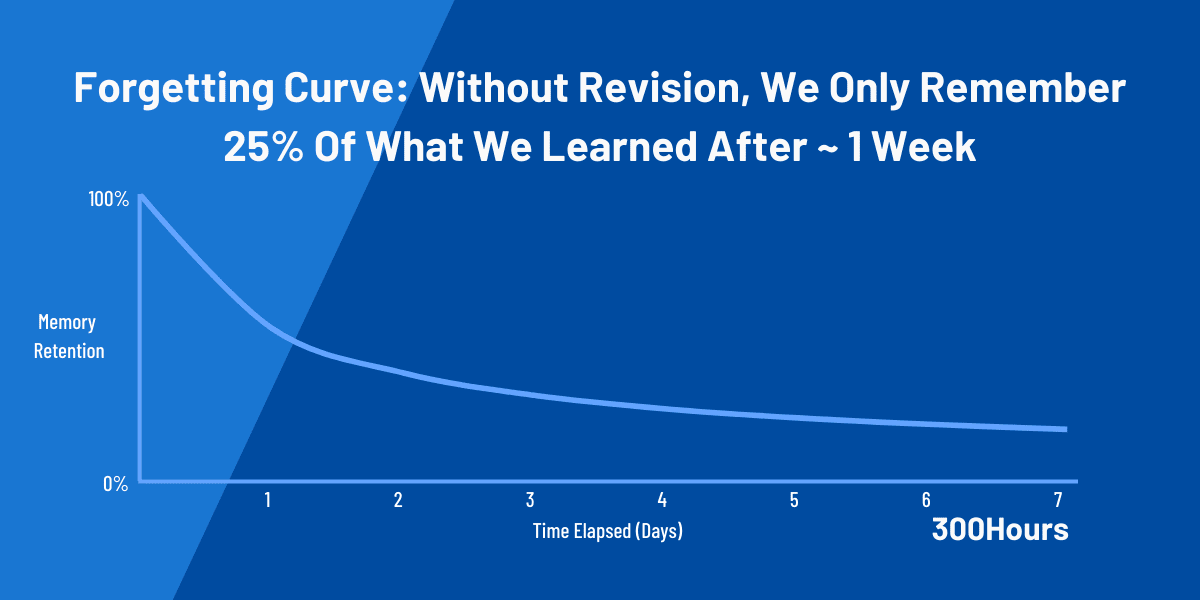
Before we start the epic quest of improving our memory, it pays to take a step back to look at the big picture that a lot of us miss: it is not just about learning how to remember more, but also how to forget less.
In other words, acquiring and retaining information are equally important.
The process of forgetting is best illustrated by the Forgetting Curve (also known as the Ebbinghaus Curve, named after the German psychologist Hermann Ebbinghaus in 1880s), which shows the relationship between time and how well we retain information.
It turns out that what we learn disappears exponentially after initial learning. If we don’t make an effort to remember, the Forgetting Curve shows that people generally only remember about:
- 58% of information after 20 minutes (!);
- 44% of information after 1 hour;
- 34% of information after 1 day;
- 25% of information after nearly 1 week;
- 21% of information after 1 month.
Combine that with the sheer volume of study materials across 10 topics, these may contribute to why CFA exams are so famously difficult.
Thankfully, there is a crucial way to combat this: by using and retrieving that information at various intervals after immediate exposure (spaced repetition), our long-term memory would be increased. This is because our forgetting curve changes shape (rate of forgetting decreases) and shifts to the right:
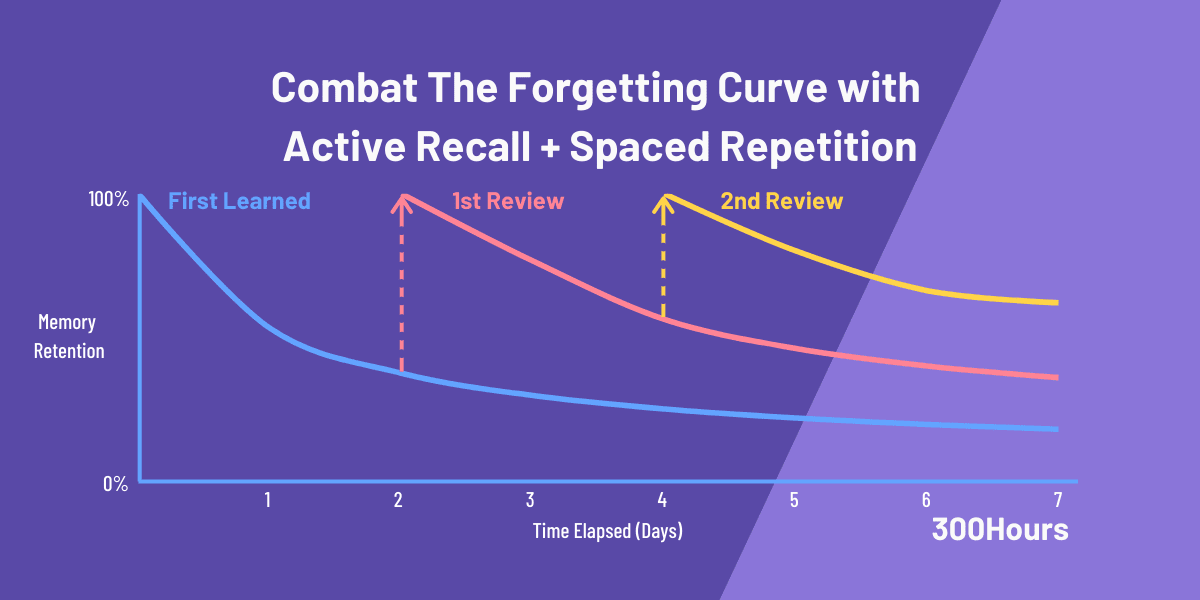
While spaced repetition is a core study technique, the most powerful tool – in our opinion as CFA charterholders here at 300Hours – is to use a combination of memory aids, effective study techniques and consistent lifestyle habits to maximize your memory retention for the exams.
And that’s exactly what we will be covering in this extensive guide, you don’t have to use all the techniques, just pick and choose what works for you.
5 useful memory aid techniques to try out
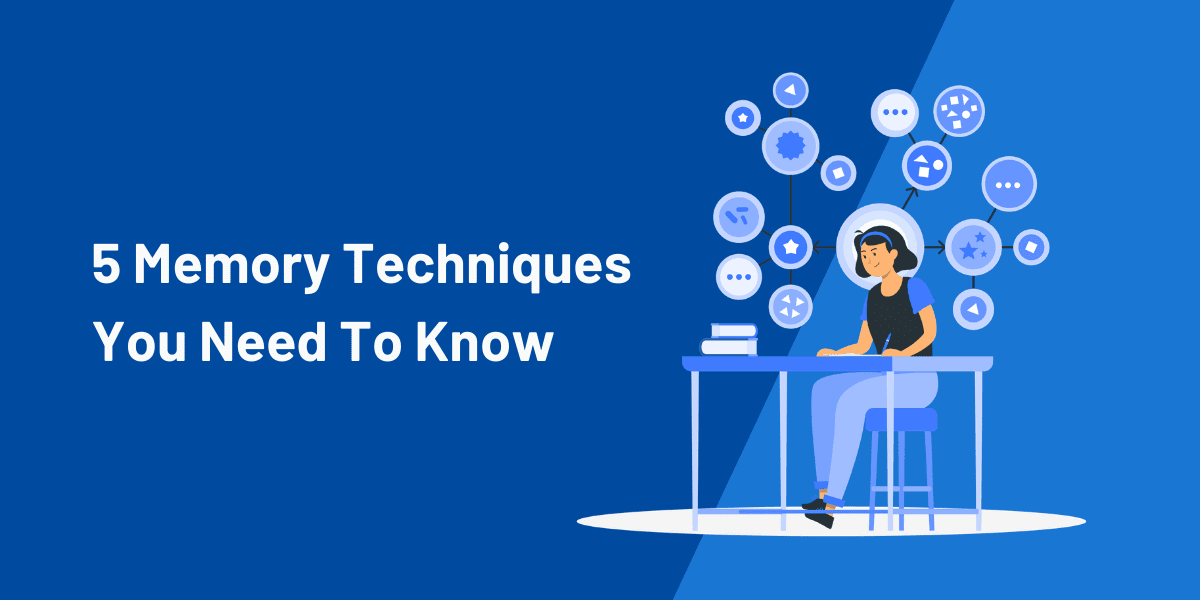
1) Mnemonics & acronyms
Just a quick reminder:
- A mnemonic is a short phrase used to remember a rule. For example, the number of letters in this phrase “How I wish I could calculate pi” gives the first seven digits of pi: 3.141592…
- An acronym is an abbreviation formed from the first letters of a series of words.
When it comes to studying CFA curriculum, it is generally best to understand (and hence naturally remember and how to apply) the concepts.
However, when it comes to specific cases of remembering list of stuff or arbitrary distinctions (e.g. US GAAP vs. IFRS rules), mnemonics and acronyms can be a highly effective tool. And yes, this statement is still consistent with scientific studies stating that mnemonics and acronyms have limited overall applicability for studying, because you can’t read and understand the whole CFA syllabus with mnemonics alone!
Personally, I’ve found acronyms particularly useful for remembering some CFA concepts across 3 levels. Here are some examples:
| CFA Level 1 Acronyms | CFA Level 2 Acronyms | CFA Level 3 Acronyms |
|---|---|---|
| NOIRIn Quant, the first letter of each word in the data measurement scale from weakest to strongest is indicated by the letters in the word NOIR (which is the color ‘black’ in French). NOIR for Nominal, Ordinal, Interval and Ratio scale. | Use “CoKe = PepSi” to remember Put Call Parity:Call + (PV of) StriKe = Put+StockK is used for Strike price here.To remind yourself of the present value (PV) of K, associate Strike price with the end time (since we usually exercise relative to Strike at option expiry). So K is linked to a risk free rate component, and needs to be discounted back to the present time where C, P, and S are. | Grinold-Kroner “DIGS PE“:In Economics, here’s a way to remember the components of the Grinold-Kroner (GK) model = Dividend Yield + Inflation + Growth – Shares + P/E RatioE(Re) ≈ D/P + i + g – ΔS + ΔP/E |
| M.B.E. (Member of British Empire)When calculating bond yields in Fixed Income, just remember that M<B<E.M= Money market yield (no compounding – 360 days p/y);B= Bond equivalent yield (semi-annual compounding – 365 days p/y);E = Effective annual yield (continuous compounding, 365 days p/y). | For Investment Policy Statement (IPS) questions, remember the “RRTTLLU” framework:ReturnRiskTime HorizonTax ConsiderationLiquidity NeedsLegal & RegulatoryUnique Circumstances |
2) Imagery
Well, they don’t say ‘a picture is worth a thousand words’ for nothing!
Images are a powerful and effective memory technique, especially for certain finance concepts or equations. It allows you to grasp a concept faster and recall it better at the same time. The goal here is to transform whatever you’re reading into something so colorful, so funny or so different from anything you’ve seen before that you can’t possibly forget it.
Here’s an example on how to remember Type 1 vs. Type 2 errors in hypothesis testing:

A quick recap:
- Type 1 error is the rejection of the null hypothesis when it is actually true (false positive).
- Type 2 error is the failure to reject the null hypothesis when it is actually false (false negative).
So the null hypothesis in the image above is “You’re not pregnant”, and the alternative hypothesis is “You’re pregnant!”. It’s a great way to illustrate the meaning and the intuition of Type 1 vs. Type 2 errors 🙂
3) Letters or sounds
For those of you who don’t connect to the previous visual example, let’s try a different method by using letters.
OK, you need to have watched Lord of the Rings for this to make sense, but here goes:
- A Type I error is when you reject the null when you shouldn’t, just like Frodo rejecting the help of Sam, his loyal friend.
- A Type II error is when you fail to reject the null when you should, just like how Frodo listened to Gollum even though he was a dangerous liar.
To distinguish between them, note that the two ll’s in Gollum look like the Roman numeral II, for a Type II error.
To use this method, do consider other secondary languages as well which could also work. As you can see, memory aids can also be highly personal, but you remember it better when it is something you come up with.
4) Make up a story

Let’s say you’re a Level 2 candidate, and want to remember that you can’t use the Durbin-Watson (DW) statistic to test for autocorrelation in an autoregressive model.
A candidate in our forum came up with this story to remember this fact, based on her favorite childhood TV show called “Arthur”: “Arthur (AR) and his sister D.W. (short for Dora Winifred) were rarely agreeable with each other, just like autocorrelation doesn’t agree with Durbin-Watson.“
Pretty good, isn’t it?
Let’s try another: let’s say you wanted to remember the components of Fama-French and Pastor-Stambaugh models to explain stock returns.
The Fama-French model has 3 components: market premium, small-cap premium, and book-to-market premium. Pastor-Stambaugh’s model is just adding a liquidity factor to the existing Fama-French’s model.
Here’s an example story to recall this:
A French farmer has 3 cows: one is sold to the market, one wears a small cap, and one loves reading books. The first cow was sold to Pastor S (Stambaugh) for cash ==> liquidity premium.
Or how about showing this story in an image (tip #2) to cement it in your mind?
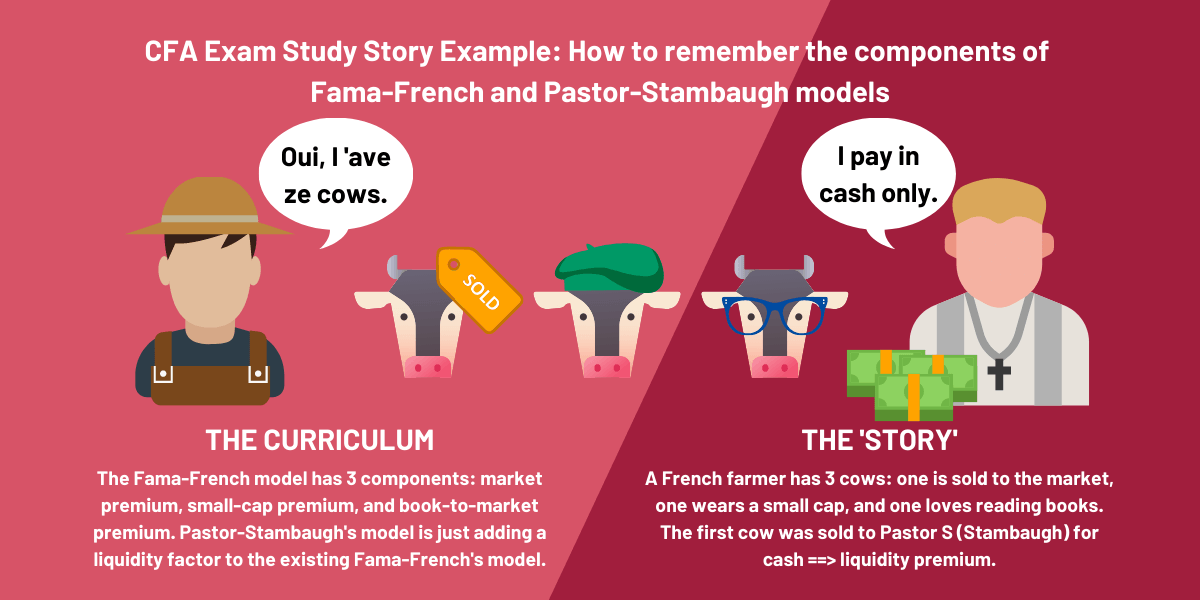
5) Use analogies
Another useful tip is to form analogies by connecting what you want to learn with similar concepts you’re familiar with to improve your understanding.
For example in Level 2 options section, we can link the concept of an option’s Delta and Gamma to a bond’s duration and convexity:
A (stock) option’s Delta is like duration for a bond. Delta/duration basically measure the option/bond price sensitivity to a change in the underlying stock price/interest rate.
Gamma measures the curve of the price line in an option, whereas convexity measures the curve of the price line in a bond.
8 effective study methods that boosts memory
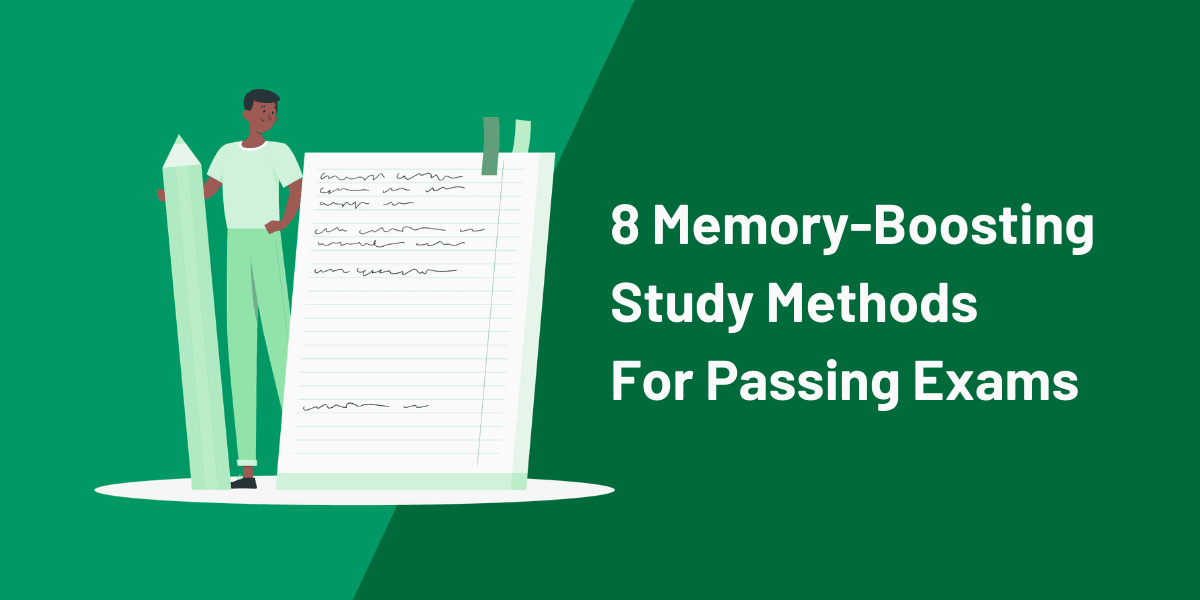
FYI – We have a separate epic guide on the best, proven study techniques for exams, check it out separately for more in-depth research (in addition to the points below).
6) Make (some) summary notes
OK, you may have heard some general advice about writing (instead of typing) your notes out to increase chances of it sticking in your brain. This is because writing in itself forces us to evaluate and categorize the new information (refer next tip #7), which helps information consolidation in our memory.
However, writing notes may not be the best use of your time for challenging financial qualifications like CFA.
Given that most financial exams (e.g. CFA, FRM) are transitioning to computer-based testing (CBT), and the sheer amount of material you need to study for these qualifications, we find that summarizing small sections of the curriculum (whether writing or typing), especially after doing a practice test, can be helpful to reinforce your understanding of why you’ve got certain questions incorrect.
In our view, CFA candidates shouldn’t feel the need to summarize large sections of the curriculum – your time is better spent elsewhere such as doing practice tests (see tip #10).
7) Organize information into bite-sized chunks (“chunking”)

For any exams (not just CFA), there are usually lists of things you just need to remember, or arbitrary distinctions, with no way of ‘understanding’ them.
You can make these lists easier to remember by organizing them into small, meaningful groups, a technique known as ‘chunking’. Imagine if your brain is like a cupboard and the contents are scattered, it’ll be a complete mess and hard to retrieve information you need. In contrast, by chunking information into small, useful units, each unit is a bucketful of information which your brain handles better.
You can see that I’ve used the chunking technique in the Table of Contents of this article, by grouping this list of tips into 3 meaningful groups called “memory techniques”, “study techniques” and “daily habits”.
Here’s another (simple) example for CFA Level 1 in Quantitative methods:
When sample statistics start to deviate, I always remember this by arranging them in alphabetical order:
Arithmetic mean > geometric mean > harmonic mean
For more extensive examples of chunking, I’ve written a few guides for CFA Level 3 candidates years ago on how to tackle IPS questions for Individual Investors, and another one for Institutional Investors.
8) Tables & diagrams
When making summary notes (see #6), another powerful method of organizing information (see #7) visually is to use tables, diagrams or even mind maps.
You can recall concepts faster versus the case of remembering a large amount of text. Here’s a case in point, when measuring and reporting financial assets in CFA Level 1:
| Held-to-Maturity | Available-for-Sale | Trading Securities | |
|---|---|---|---|
| Balance Sheet | Amortized Cost | Fair Value | Fair Value |
| Dividend, Interest & Realized Gains & Losses | Income Statement | Income Statement | Income Statement |
| Unrealized Gains & Losses | Not reported | Other Comprehensive Income (OCI) | Income Statement |
Or to go back to the earlier examples of Type 1 vs. Type 2 errors, here’s a different way to understand it via a table:
| H0 is true | H0 is false | |
|---|---|---|
| Reject H0 | Type 1 Error | Correct rejection |
| Fail to Reject H0 | Correct decision | Type 2 Error |
9) Teach others
Helping others by teaching what you know has a surprising benefit of reinforcing what you’ve learned – a nice win-win for all 🙂
That’s what our readers do in our forum too, which has a strong focus on answering every CFA candidate’s questions.
10) Practice testing
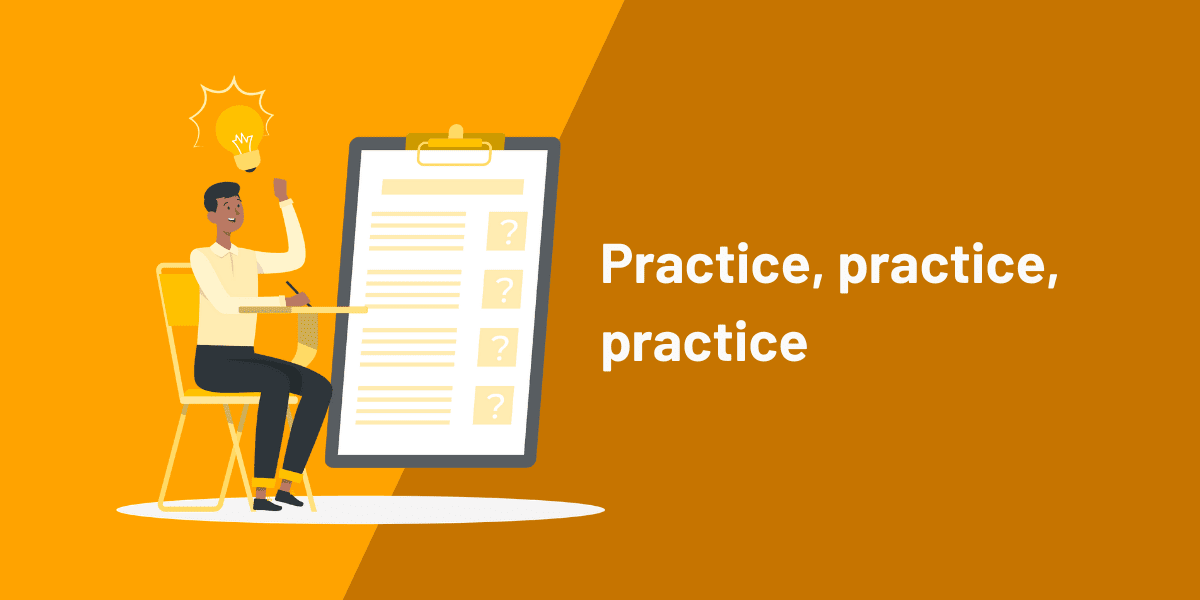
It is scientifically proven that one of the most effective way to boost your study memory is via practice testing, where you actively practise retrieving the information.
Active recall via practice testing (e.g. doing question banks, practice exams or using flashcards – see #13) is a better use of your time than passive recall study activities, e.g. (re)reading your notes or watching video lectures.
There’s loads of evidence that practice testing improves learning across an impressive range of practice-test formats, types of material, learner ages, outcome measures, and retention intervals.
11) Interleaved practice
Interleaved Practice involves students practicing on a mix of different types of problems (from different chapters) in one go. For CFA candidates, you are doing this when attempting mock exams which contain questions from all topics in the syllabus.
In contrast, the opposite of interleaved practice is “Blocked Practice”. This is where all problems of one type are practiced, before progressing to the next topic. For example, doing the end-of-chapter questions after reading a sub-topic.
While Blocked Practice is important after each reading, Interleaved Practice is a must for CFA candidates to sufficiently prepare for the exams. This is because it teaches you how to apply and discriminate between how to answer different questions in a mixed-question test, which leads to greater material retention.
FYI – we also have a bunch of free practice tests available for our readers at every CFA level!
12) Spaced repetition
Also known as distributed practice, this powerful method is all about spreading your studies over time (vs. cramming).
There is strong empirical evidence for the benefits of spaced repetition. Spacing out your learning into bite-sized chunks, and reviewing them over increasing intervals improves long term retention as more information are encoded into long-term memory (see Forgetting Curve above at the start of this article).
This also ties in with our recommendation of starting your studies around 6 months before the CFA exams (try our study planner!).
13) Try flashcards

Often misunderstood as just tiny, colourful cards with notes, flashcards are actually for testing rather than summarizing.
In fact, they are an immensely useful study tool that combines 3 of the most productive study techniques: practice testing, spaced repetition and interleaving.
Here’s how it works:
- Flashcards are sets of small, double-sided cards used to learn and revise via practice testing. It is NOT a place to write summary notes, but to have 1 question or key term on one side, and the answer or definition on the other.
- As you go through your flashcards, you pause and think before looking at the answer at the back of the card. It is this process of active recall (regardless if the answer is correct or not) that helps boost long term memory.
- Then, you organize them by how well you know the concepts. For those that you don’t know well, put them in the “weaker” pile, and you retest this pile of cards sooner compared to those topics you’re “stronger” in. Hopefully over time, your “stronger” pile increases as you review.
Flashcards are also highly portable, which allow you to take advantage of short amounts of time that become available throughout the day or week, in addition to during planned study sessions.
When created and used properly, flashcards are an extremely powerful tool for revision. It allows candidates to:
- actively recall their materials when answering a question (practice testing, see #10),
- repeated over a period of time (spaced repetition, see #12),
- exploit the benefits of interleaving by mixing up several decks of flashcards covering various topics (interleaved practice, see #10)
You can try the technique by creating your own flashcards for a few readings to start. Alternatively, as time is precious for the CFA exam preparation, it may make more sense to purchase readymade CFA flashcards from 3rd party providers.
5 healthy daily habits that improves memory recall

14) Go for a walk
Researchers have found that even very light workouts, such as a 10 minute walk, can increase the connectivity between parts of the brain responsible for memory formation and storage.
Given this evidence, the best time to do this is before starting a learning session or during a study break.
Of course, if you can commit to a longer, regular aerobic exercise regime, that’s even better!
15) Read out loud
OK, this isn’t a lifestyle change per se, more of a study hack you can use.
A 2017 University of Waterloo study found that reading aloud to yourself helps you remember it in the long run, called the “production effect”.
The study tested 4 methods for learning written information, including reading silently, hearing someone else read, listening to a recording of oneself reading, and reading aloud in real time. The results show that the production effect of reading information aloud to yourself resulted in the best remembering, as it is the dual action of speaking and hearing oneself that has the most beneficial impact on memory.
So, if you’re studying alone and come across a particularly difficult part of your study session, try reading out loud for a change!
16) Sleep after learning something challenging

OK, we all know that having sufficient restful sleep is crucial in the memory consolidation process.
But did you know that going to sleep within a few hours after a study session will help you better remember the material you just studied?
There is also some evidence that having a daytime nap after learning also boost retention due to the enhanced consolidation and/or encoding associated with sleep.
What does this tell us?
- As part of your CFA study plan, it makes sense to schedule in a minimum of 1 hour study time for at night before sleeping;
- If you’re studying most of the day on weekends, it is worth slotting in a quick daytime nap between studies for some energy and memory boost.
17) Drink coffee strategically

There are so many conflicting studies or inconclusive evidence on coffee and its effect on short and long term memory.
But here’s what we know:
- Caffeine (in coffee) is a natural stimulant for the brain. It increases our focus and concentration which would be helpful for learning.
- However, it has some notable downsides too, such as irritability, caffeine dependence and insomnia. Remember that the amount and quality of sleep influences learning and memory, so there is a trade-off here we need to balance.
Given this, I came up with several rules of thumb to use coffee strategically as a tool to improve concentration during my CFA studies:
- First, to control the negative effects of caffeine, there needs to be a limit you can have a day, and the latest cut-off time you can have it to ensure you have good quality sleep at night.
- The best time to drink coffee is actually around 930-1130am, because you don’t need it first thing in the morning as you’re at your natural alertness peak.
- Have a a strict coffee cut-off time of 2pm in the afternoon as caffeine has a half-life of 5 hours.
- Then, here comes the hard part (which requires discipline if you love coffee like me):
- You need to “detox” and get rid of your coffee habit first for a few months. Then, use it sporadically in small doses and only as needed.
- You cannot have a cup daily as it increases your chances of caffeine dependence, which would require an increasing dose over time to achieve the same boost in concentration.
- For more details of my experience and the whole “caffeine detox” process, check out this article →
18) Look after yourself

Take a deep breath (last tip, yay!) – whilst CFA exams are important for your career goals, it is good to take a step back and look at the bigger picture here.
Whilst passing the CFA exams are important, looking after yourself physically, mentally and emotionally is crucial in the longer run to excel in the game of life.
And this means:
- Getting enough good quality sleep – this is beneficial for improving memory as well. Recognize the signs of sleep deprivation, and make sure you allocate time better before the exams as it will negatively impact your performance.
- Eating well and maintain a good diet to keep healthy, and reducing booze intake.
- Incorporate physical activities daily as a new habit, 20 minutes is all you need!
- Know the signs when you’re starting to burn out – significant lack of drive to study, increased irritability and mild depression. Remember to take time off studying every week, and monitor your study progress to stay on track.
Which memory techniques do you find useful for your exam preparation? Do you have further memory-boosting tips to share? Let me know in the comments below!
Meanwhile, you may find these related articles of interest:

Amazing strategies, thank you for sharing, I highly agree on finding the right balance to optimize your body and mind to tackle this big monster.
One suggestion that i would add is study groups, having a support network of like minded individuals goes such a long way, helps stay on track and your form lasting friendships. Good luck and stay well!
Thanks a lot, Sophie. Would surely be quite useful to me.
Thank you Sophie for this amazingly insightful article. I was feeling so down about the exam since it’s been keeping postponing from the last 2 times but this article made my day and now I will get back to the study with even more improved tactics, thanks to you for this. Cheers! Have a good time.
Thanks Jinesh – glad it cheered you up a little! Sorry to hear about the postponements, it must be frustrating not being able to take the exams. Hope it helps in your revisions, do tell me which technique worked best for you 🙂
This’s SUPER useful! I definitely needed that, thank your so much for your efforts!
You’re welcome Norah – I’m delighted you found it useful. Took me ages to write this long post, wished I had it when I was a CFA candidate for sure!
very useful post!
Cheers Marlon – feel free to share this with your friends and hope it helps with your CFA studies!
amazing tips – thank you
Thanks Ed, you made my day!
Thank you for these useful resources, and all the variety of information and links provided.
You’re welcome! I’m glad you’ve found it useful